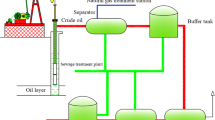Abstract
In this paper, to improve the current efficiency in the copper electrowinning process is taken as the research objective. In the traditional production process, sulfate ion concentration, copper ion concentration and current density are carried out according to the empirical value, which cannot ensure the current efficiency to reach the optimal level. Therefore, firstly, this paper proposes a BP neural network model to improve the current efficiency according to the relationships between sulfate ion concentration, copper ion concentration, current density and the established BP neural network model is trained by using real data from the enterprise. The simulation results indicate that there is a definite error between the predicted current efficiency and corresponding to the current efficiency measured at the production site. It is proposed that the BP neural network improved by the improved PSO to further improve the prediction accuracy of the BP neural network. Simulation results indicate that the prediction error of the current efficiency is greatly reduced that meets the accuracy requirements. On the premise of guaranteeing the quality of copper electrowinning, the current density, sulfate ion concentration and copper ion concentration corresponding to the maximum current efficiency accurately predicted by this method can be respectively adjusted in real-time in the copper electrowinning process, which realizes the optimization of current efficiency in the process of copper electrowinning under the background of low carbon and environmental protection.






Similar content being viewed by others
Data availability statement
The [Production Process Data of Copper Electrowinning] data used to support the findings of this study are currently under embargo while the research findings are commercialized. Requests for data, 12 months after publication of this article, will be considered by the corresponding author.
References
Maolan Z, Tao T, Gensong Z, Jue Y (2014) Status and development of copper electrowinning technology. Nonferr Met (Smelt Part) 08:9–13
Meiju Z (2009) Study and application of energy consumption optimization method of zinc electrolysis based on multi-objective particle swarm optimization. Central Southern University, Changsha
Yi Z, Yongjun X, Chunlin L (2016) Exploration on reducing energy consumption of electrodeposited copper in hydro-process production. Yunnan Metall 5(04):42–46
Yi J, Bai J, Zhou W et al (2018) Operating parameters optimization for the aluminum electrolysis process using an improved quantum-behaved particle swarm algorithm. IEEE J Trans Ind Inform 14(8):3405–3415
Qingzhi Z (2008) Multi-objective genetic algorithm and its application in copper electrolysis process. Northeastern University, Boston
Ke Y (2017) Application research of BP neural network optimized by genetic algorithm in port throughput prediction of lianyungang port. Shenzhen university, Shenzhen
Fu WX, Liang CH (2014) BP forecast model based on improved PSO algorithm. Comput Syst Appl 23(4):135–137
Zhongbao L (2019) Prediction of dam deformation by optimizing BP network through improved adaptive PSO. Geod Geodyn 39(05):528–532
Li W (2020) Optimization scheduling of micro-grid based on improved Particle Swarm Optimization. Hubei University of Technology, Wuhan
Minghui H, Yi X, Ran W et al (2018) Combination dynamic inertia weight particle swarm optimization algorithm to optimize neural network and application. Comput Eng Appl 54(19):107–113
Acknowledgements
The paper was supported by the education department of Jilin Province (Grant: JJKH20200044KJ), the Jilin Provincial development and reform Commission (Grant: 2018C035-1), Jilin provincial science and technology department (Grants: 20160101276JC and 20150312040ZG). Project of Beihua University (Grant: 201901012).
Author information
Authors and Affiliations
Corresponding author
Additional information
Publisher's Note
Springer Nature remains neutral with regard to jurisdictional claims in published maps and institutional affiliations.
Rights and permissions
About this article
Cite this article
Wu, J., Cheng, YM., Liu, C. et al. A BP Neural Network Based on Improved PSO for Increasing Current Efficiency of Copper Electrowinning. J. Electr. Eng. Technol. 16, 1297–1304 (2021). https://doi.org/10.1007/s42835-021-00678-9
Received:
Revised:
Accepted:
Published:
Issue Date:
DOI: https://doi.org/10.1007/s42835-021-00678-9




